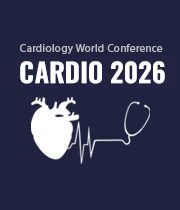Intracardiac Electrogram
The Intracardiac Electrogram (IEGM) stands as a fundamental asset in the field of cardiology, serving as an invaluable diagnostic instrument. It provides real-time observations into the dynamic electrical activity within the heart, allowing healthcare practitioners to delve into the intricacies of each cardiac cycle. This specialized recording technique involves the insertion of catheters directly into the heart chambers, enabling the precise capture of intracardiac signals. Through the Intracardiac Electrogram, clinicians gain a comprehensive understanding of the heart's conduction system. This diagnostic tool proves particularly adept at identifying irregularities and abnormalities in the electrical patterns of the heart. By meticulously recording these signals, healthcare professionals can analyze the heart's rhythm, facilitating the detection of arrhythmias and other cardiac conditions.

Arthur J Siegel
Massachusetts General Hospital, United States
Sergey Suchkov
N. D. Zelinskii Institute for Organic Chemistry of the Russian Academy of Sciences, Russian Federation
Narendra Kumar
HeartbeatsZ Academy, United Kingdom
Arthur J Siegel
Massachusetts General Hospital, United States
Yong Xiao Wang
Albany Medical Center, United States
Narendra Kumar
HeartbeatsZ Academy, United Kingdom



Title : New recommendations for the prevention of sudden cardiac death in athletes and recreational sports
Sekib Sokolovic, ASA Hospital Sarajevo, Bosnia and Herzegowina
Title : Coronary revascularization in patients with diabetes: Prospects for stenting in patients with type 1 diabetes and coronary artery disease
Mekhman N Mamedov, National Research Center for Therapy and Preventive Medicine, Russian Federation
Title : An adult case of polysplenia syndrome associated with sinus node dysfunction
Apoorva Tripathi, Oxford University Hospitals, United Kingdom
Title : Personalized and precision medicine (PPM) as a unique healthcare model through biodesign-driven translational applications and cardiology-related healthcare marketing to secure the human healthcare and biosafety
Sergey Suchkov, N. D. Zelinskii Institute for Organic Chemistry of the Russian Academy of Sciences, Russian Federation
Title : A unique cell-driven phenomenon in the heart and the promising future of the innovative translational tools to manage cardiac self-renewal and regeneration
Sergey Suchkov, N. D. Zelinskii Institute for Organic Chemistry of the Russian Academy of Sciences, Russian Federation
Title : Young hearts at risk: Hidden cardiovascular damage and the role of social determinants of health among youth with type 1 diabetes in Kenya
Phoebe Wamalwa, Ministry of Health, Kenya